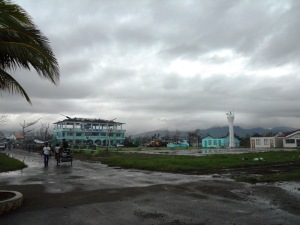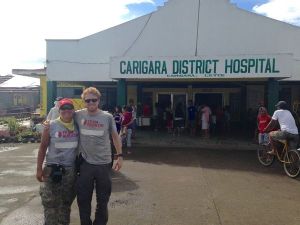After spending a week seeing the devastation in and around Tacloban last November, maybe the most surreal feeling I had during my time in the Philippines post-Haiyan was taking a walk on the pier on Carigara Bay. Why surreal? Because a walk on the pier on a quiet, calm evening seemed almost normal in a region that had suffered incomprehensible devastation. You could just walk out more than a hundred yards away from a wrecked town, where the calm lapping of the water and the broad expanse of slate blue, the hazy mountains of Samar looming far in the distance, and the grainy outline of Carigara’s shoreline made the storm’s impact seem so far away. Dozens of locals came out here for a sense of normalcy, too. Groups of men chatted and tended fishing poles. Couples talked and smiled. Others, like our group of Team Rubicon volunteers, just relaxed and enjoyed the peacefulness.

Initial assessment of Carigara, talking with a helpful, but exhausted, volunteer working at the LGU. Photo by Kirk Jackson, Team Rubicon.
We were in Carigara following an assessment our team had done a few days earlier. Carigara was situated on the north shore of Leyte, and its location on the bay rather than on the eastern ocean shore meant that the town was spared the multiple 20-24-foot waves of storm surge that had hit Tacloban and the ocean-facing coastline, washing away entire neighborhoods. But Carigara nevertheless experienced wind force equivalent to a T4 tornado, which tore through buildings, flattened small structures, and whipped power lines and metal corrugated sheeting across the area.
On our first visit to assess Carigara, we stopped at the hospital, which served a cluster of nearby towns and villages. The hospital had no power, and little of its roof was left free of gaping holes and major leakage that poured through during the incessant rainstorms that blew through every day. There was standing water and debris all through the hospital, costly equipment was ruined, and dozens of patients lay on beds that had been pulled tightly together into a small ward, in almost complete darkness, that was less leaky than the rest of the hospital. The only nurse on duty had already been awake and working for more than 24 hours straight. It was clear that they could use some help.

The damaged Carigara LGU, where municipal workers lived and worked around the clock to help their town.
We also visited the Local Government Unit, or LGU, building, which itself was damaged, but it bustled like a beehive of municipal workers, local residents, and volunteers that had come in from Manila or elsewhere in the Philippines to help. We spoke with a young woman who was volunteering with the LGU who had been working continuously for days to help compile data and organize the distribution of rice and other food aid to local neighborhoods. She was exhausted, but was happy to talk with us and give us a smile, as well as show us the latest statistics for Carigara. The LGU had the town’s most accurate numbers to date on how many people were displaced, how many homes destroyed or damaged, how many injuries, how many fatalities. All statistics were certified at the local level; from there, it was a matter of communicating this data–reflecting the needs of real people–to the central government and to the United Nations coordination cells so the appropriate aid could get piped in. I’m proud that Team Rubicon played a critical role in the early communication of some of this vital information.
At the request of the Philippine Department of Health, and welcomed in by the mayor of Carigara, Team Rubicon ended up sending follow-on teams here to help with structural support and medical aid, helping to give the hospital dry space to work in, and a surge in staff and supplies to see patients who came in from across the region. Within the first 36 hours of the medical team setting up in Carigara, they saw more than 500 patients.
I spent only a short time in Carigara because I’d already been in Leyte for more than a week, and I was only staying on the ground long enough to make a transition to Team Rubicon’s second wave of “Operation Seabird” before heading back home to my normal life. But just as my experience in Tacloban was life-changing, what I learned and experienced in Carigara deepened my understanding of what it meant to help people in the Philippines. I learned what it meant to experience bayanihan–coming together as a community to get the job done.
We were welcomed to Carigara by the selfless, hardworking beehive of workers in the LGU. The mayor and other elected officials of Carigara shook our hands, thanked us, and offered every last bit of hospitality they could muster–to include a college alumni house that served temporarily as Team Rubicon’s bunkhouse. We had LGU hosts who gave us updates, offered smiles and laughs, and made us feel like part of the community and part of the larger team that was working hard to get Carigara back on its feet. Retirees, government officials, and other local residents chatted with us and shared stories of what it was like to weather the frightening, massive storm in Carigara. Neighborhood kids flocked around us as we worked around the hospital, helping to carry wood or pull nails out of salvaged boards, and cheering us all on by name. We weren’t just helping a community; we became part of the community.
That evening we walked out on the pier, exhausted from a day of working to improve the roof of the hospital, it was a wonderful thing to be out there, feeling for a moment like a Carigara local, as part of Carigara’s bayanihan. One of the locals we talked with was a college professor, who told us not only his personal experience of the typhoon, but also gave us a history lesson on Carigara. “Our town was once capital of this entire region,” he said, pointing out over the water to the island of Samar in the distance, “both Leyte and Samar.” This was long before Tacloban grew large and the capital was relocated there. Carigara was founded in the 1300s, and the Spanish came and settled in 1571, and established a Jesuit mission there–and laying a foundation for a city that flourished for centuries. “We are proud of our Carigara,” the professor told us. “Thank you for coming to help us rebuild,” he said. I was proud, too. And honored that I could feel, even for a short time, that same sense of pride in our Carigara–because that day, I was a Carigara local.




Thank you too to your team Rubicon.. More power!!
LikeLike
Thank you so much team Rubicon,you made a difference to our beloved town..in helping rebuild of what was left after Haiyan..
LikeLike
thank you for helping us. we truly appreciate your time and effort. god bless
LikeLike
Thank you!!!
LikeLike
Thank you so much for all the help extended to us by team rubicon!!!God Bless you all!!
LikeLike